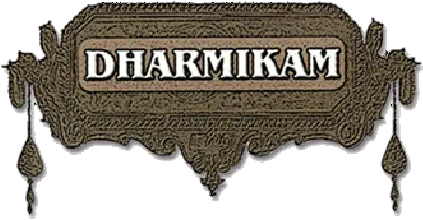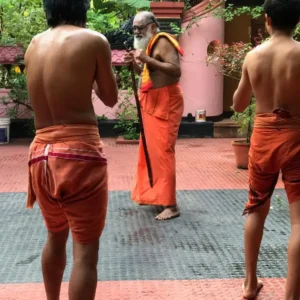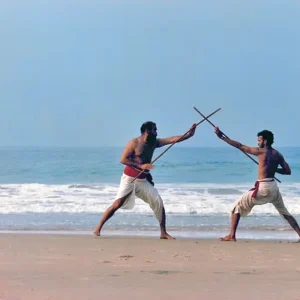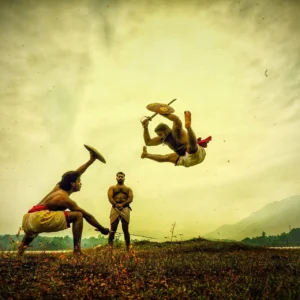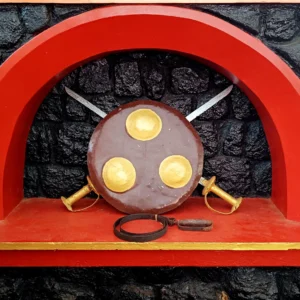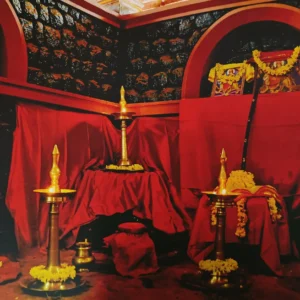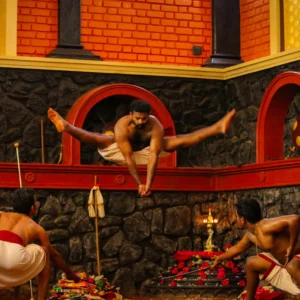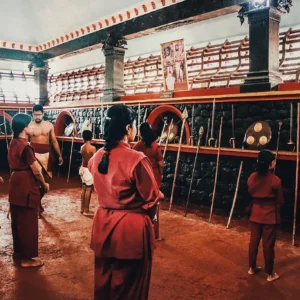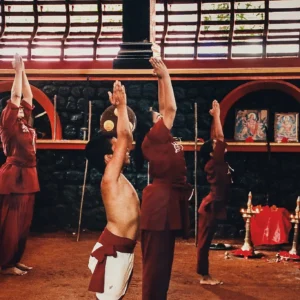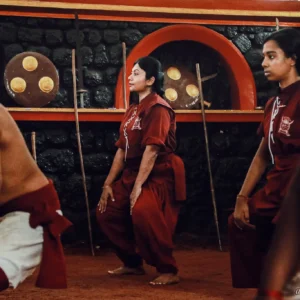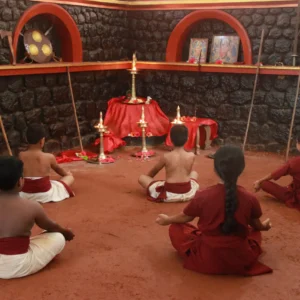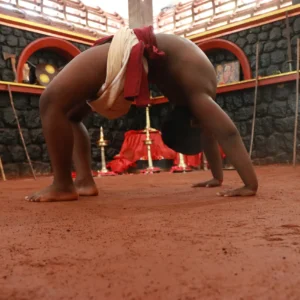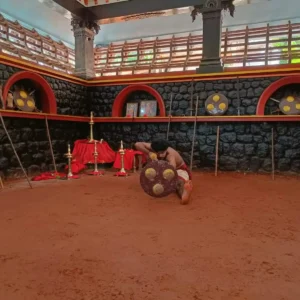The Kalari
The Ashram is home to the World-renowned Indian School of Martial Arts (ISMA) where the ancient art of Kalaripayattu is practiced and taught.
ISMA was originally started in 1983 by Guru Balachandran Nair to impart training in Indian Martial Arts to younger generations. Over the years, ISMA has imparted training to several thousands of students all over the world and gained wide popularity through several documentaries and films. In 1993, ISMA Vazhuthacaud was established in Trivandrum city. As the Ashram was inaugurated in 2003, the headquarters of Kalariyil Dharmikam Ashram was shifted to Parasuvykal. Both the centers are active and accept students interested in learning kalarippayattu.
The Tradition of Kalaripayattu
Kalaripayattu is the oldest existing martial art form, and its tradition dates back more than 12,000 years. The name is derived from the Sanskrit word ‘Khaluriga,' which means warfare. It is considered the most dangerous martial art because of the application of power and speed to ‘marma' (pressure) points of the body. According to tradition, this art originated from the Dhanurveda, which encompasses all the fighting arts. It is one of the eighteen traditional branches of knowledge according to the Vishnu Purana.
Origins of the Kalaripayattu tradition
Kalaripayattu is indigenous to the Southern state of Kerala, where the sixth incarnation of Vishnu Lord Parashuram is said to have been created from the ocean. In order to protect this land, Parashuram passed his knowledge of Kalaripayattu to his 21 disciples. According to tradition, he then sent these disciples to various parts of Kerala. Keralites, therefore, consider Kalaripayattu to be God's own martial art that has the power to protect God's own country. The knowledge of this art has passed through many generations, from its beginning to the present day.
Because the Buddhist monk Bodhidharma took Kalaripayattu from India to China in the fifth century, Kalaripayattu is also the predecessor of Chinese martial arts. Once it was brought to China, practitioners of Kalaripayattu merged the art with existing fighting forms.
This merging marked the birth of Kung Fu.
Later in the tenth century, the Portuguese traveler Durad Barbossa recorded in his travel log that he witnessed the Nair warriors practicing this art.
Kalaripayattu is part of the honor, inheritance, and culture of India, especially of the Keralites. Their warrior clan believed that fighting for the sake of the country was a great honor, and practiced the art as their birthright. Centuries ago, the Travancore armies fought many wars using these techniques, including three wars against the Dutch Navy. Veluthamp Dalawa and Pazhassi Raja are just two of the many warriors who used these martial arts against the British. Intimidated by these freedom fighters, the British banned martial art during their rule in India. Those who wished to preserve the art had to practice Kalaripayattu in secret.
The Two Schools
There are two distinct traditions of teaching: the Northern and the Southern schools. In the Northern tradition, Masters emphasize progressing from body exercises to combat using weapons, and finally to unarmed combat. In the Southern tradition, the patron saint of Kalaripayattu is the sage Agastya, whose strength and powers of meditation are legendary. The Southern tradition emphasizes footwork, movement, and the ability to strike at ‘marmas' in the opponent's body, 108 points of which are lethally vulnerable.
One who practices Kalaripayattu learns how to fight and defend oneself. However, he not only strengthens the body but trains the body and mind together, through the spiritual nature of the art. Once the body and mind are strong, the two are synchronized into one channel, which is a crucial part of the practitioner's spiritual progress. Kalaripayattu, therefore, has an essential role to play in eradicating the root causes of moral degeneration. Additionally, there is the service to society; as it helps students to grow physically and mentally strong, which fosters confident, well respected, and disciplined citizens of India.
At this time, the tradition of Kalaripayattu is being kept relevant and revered by a few great masters, such as our Satguru Hanuman Das, who have dedicated their lives to keeping the tradition alive for future generations.
Kalaripayattu Training Courses
It's a step-by-step training schedule demanding discipline and dedication. It advances through different levels and a general timeline is provided below based on students’ ability to understand the tenants of the practice and demonstrate mastery of the level. After each level, a test will be conducted to assess student performance.
- Basic Level: Includes various fitness, flexibility training, and unarmed techniques through which the student achieves mastery over his body movements.
- Intermediate Level: The student is trained to attain agility, flexibility, and coordination of body movements. They start practicing with blunt weapons.
- Advanced level: Training includes both practice with blunt weapons such as Kuruvadi, Long session staff/ Neduvadi, and sharp weapons dagger/kathi, etc. There is basic level training in marma or vital points.
- Instructor Level: Involves proficiency in the use of advanced weapons and marma points.
| Levels | Duration | Practices |
|---|---|---|
| Basic Level 1 | 3-4 months |
|
| Basic Level 2 | 6 months |
|
Benefits of Kalaripayattu in combination with Kalari Chikilsa Treatment programs:
- Improves strength, balance, and flexibility.
- Improves skeletal alignment, which can aid in back pain relief.
- Tones and strengthens muscle, which can ease joint pain.
- Increases metabolism.
- Reduces stress, and aids in sleep.
- Improves energy through deep breathing and improved oxygen levels which can help stabilize mood.
- It helps one manage stress through the focus of the breath, gaze, and body movement synchronicity.
- It connects you with a supportive community.
- Promotes discipline which aids in all aspects of self-care.
Indian School of Martial Arts – Vazhuthacaud School
Located in the heart of Trivandrum city, Vazhuthacaud School was started in 1993 by our Guru. The school has trained many students worldwide and was featured in many documentaries and renowned magazines. The school continues to impart training in kalarippayattu for all ages. Registration for admission is through the general office number listed in the Contact information.
Online classes for senior instructors around the world are provided weekly.
Registration
Contact us through the website or in person at the ISMA Office.
Expectations
All students are expected to maintain the decorum as detailed in the Dharmikam Ethics Statement.
We do not support or encourage the use of this martial arts for any purpose other than its spiritual and physical well-being.
Students are strictly forbidden to use illicit drugs, smoking, etc. and, use of this could result in immediate termination.
We strictly forbid any political, religious, or other discussions within the school premises.
We strictly forbid discriminatory behavior based on age, sex, race, or ethnicity.
Since both males and females practice together, we require the utmost respect from all students and any derogatory statement or communication will result in immediate termination.
All students are expected as part of their learning to do seva or volunteer service within the Ashram premises.
What Others Are Saying

My first visit to this magical spot on the globe. The spirit of the Ashram and its wonderful family have
made this week joyful, nurturing, inspiring and restorative. I can’t thank everyone enough who
assisted with all the arrangements and excursions. The food – nutritious and always tasty. The
treatment healing, I look forward to returning again soon. Namaste
Elizabeth Ferber
Ponte de Limo, Portugal

Thank you ashram and thank you Swamiji.
Thank you to Swamiji For his help and his consultation. I cleared up many doubts and confusion that I have, in my mind. Swamiji and his staff help me with the physical treatment of very high quality, which helps me to recover my health very fast. The ashram is a beautiful place to stay. The people are friendly and everything was fantastic. For sure I will visit again in the future.
NICOLO FERRARI

Dear Guruji,
When I came here I realized that I should have raised my son here under your care and guidance in the ashram. My son connected with his inner self here and for that, I will always have gratefulness in my heart for Kalariyil Dharmikam. Thank you, Guruji.
Regards,
BOBBY ROY CHOUDHURY

I, Tejas, Age 30, have been part of this Ashram for a long time now. One month ago, I got a shock in the form of a blood test report, which said that my fasting blood sugar was 480. I did a postprandial blood sugar test and it was around 550! Hb-AIC which indicates the status of diabetes was at 10g, which meant I have had undiagnosed and uncontrolled diabetes for some time. I immediately called Swamiji and told him about it. He advised me to come here, to the Aashram, for treatment, to which I listened.
Swamiji first asked me to go to a good hospital nearby, where he arranged for me to undergo a complete physical check-up, including sonography of my internal organs, cardiac echo, and other tests.
After examining those reports he created a treatment plan and explained it to me. He gave me Ayurvedic medicines, medicinal food, and other treatment.
In LESS THAN ONLY A WEEK my sugar level came down. After only two weeks my sugar level was consistently around 110. Now after 1 month I am leaving with a blood sugar of around 92! He did it without any allopathic medicine!!!. Swamiji, you saved my life, And this was not the first time you saved me either. I can never thank you enough
THEJAS
MAHARASHTRA

I thank Guruji for all his help provided in our bad times, his experience and transfer nature is unique. I think the whole ashram for the unexpected service provided to us.
PRAGATEJ H KHARAT
MUMBAI

Have a great experience visiting here, experiencing the natural atmosphere, and learning many things about KALARIPPAYATTU and its history. and had great interaction with Guru and staff members.
N. DHANABHARATHIMEENA
TAMILNADU

We had a rejuvenating experience at the Ashram, especially my Mother who was cured. The ambiance of peace and quiet was much needed from the city life, hectic and chaotic found peace and much-needed rest. Thank you, Swamiji. looking formant to coming back again.
USHA SURI, PRETHAP SURI, GEETHA SURI
HYDERABAD

I have a great experience when I look at my son very good, great experience. He learns about many things. Guruji was great. I think Guruji’s staff members are very nice, thanks to everyone who works with Guruji.
LIMBODRI GOUD & NIVED GOUD
TELANGANA

I am JITENDRA, age 44 yrs, I have come from Lucknow for the treatment of my shoulder pain. I am thankful to Swamiji and everyone here who helped me with the treatment and my recovery. I feel much better now and am going back tomorrow in better health than I came here.
I also visited in 2010 for treatment of my big toe which was injured due to slipping when I was running. That time I took treatment for 15 days and my big toe recovered very much within those 15 days and became completely healthy within a month after going back from here. My heartfelt thanks to Swamiji and everyone here.
JITENDRA
LUCKNOW

How shall I even start to describe my time at the Kalariyil Dharmikam Ashram. Let me try with Gratefulness, Love, Strength, Community, Compassion, Laughter and lots of food.
The ashram family is exactly that- a family that will make you feel included as one of their own. They share without a shred of a doubt, they support with all their kindness, they go above and beyond for you all just to make you happy and feel loved.
I don’t want to choose which part I liked best- martial arts on the rooftop in the palm trees, treatments that make everyone look 20 years younger, breathtaking temples and spiritual energy wherever you go, a connection to god around you and in yourself by beautiful created poodjas or the mediation in caves or shrines- always connected to nature, always with gratitude to those who came before us, who taught us and who always will be with us.
But if had to choose it would be the people because even without all that without the amazing hospitality, the food, the comfort of the accomodation, I would always and will always return for its people.
I came in search for something within me but what I found was unconditional love all around me that made me believe again that we are taking care of all of us within us. So I am leaving for now with lot’s of colourful memories and energizing love that will always be part of me from this day on.
To these amazing people that made me and will make you believe in the change for the better again. I love you
Alissa Böhm
UK
© 2025 Kalariyil Dharmikam Ashram. All rights reserved.
Privacy Policy
